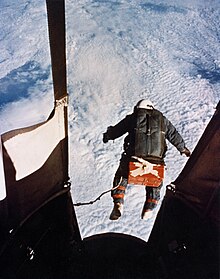Stratospheric jump

Stratospheric jump refers to a parachute jump from the stratosphere , i.e. a jump from a height above the troposphere that, depending on the latitude, reaches up to about 8 to 18 kilometers. In the English-speaking world, has advocated in contrast to the term "Sky diving" for skydiving, the term "space diving" established, although the beginning of the space (Engl. Space ) by the International Aeronautical Federation (FAI) in the Kármán line was set at a height of 100 kilometers.
A stratospheric jump is very different from simple parachute jumps. Initially, the required altitude cannot be reached by plane , which is why a helium balloon is used instead . In addition, a jumper in the vicinity of the stratosphere needs a spacesuit for protection . The speed that is reached during free fall is up to 1,300 km / h. A braking parachute can be used for a stable free fall.
history
The history of the stratospheric leaps is closely associated with the development of aviation and aerospace in the 1950s, by which the first cracks were initiated from the stratosphere to research and development purposes. The American project Excelsior , in the course of which Joseph Kittinger completed three jumps in 1959 and 1960 and set several records , became particularly well known . Stratospheric jumps were also made by Soviet space pioneers during this time , for example in 1966 by Svetlana Savitskaya and Evgeny Andrejew , who in 1962 was able to complete the longest free fall to date (Kittinger had used a control screen). Andreyev jumped on November 1, 1962 together with Pyotr Dolgow . The jumps were used to test the exit device and the spacesuits of the Vostok capsule. Dolgow got a leak in his space suit when he got out and was killed by the loss of pressure.
After Nicholas Piantanida was killed in record attempts in 1966, which for the first time served less research than mass media purposes, it was not until the beginning of the 2000s that new attempts were made to surpass the records from the 1960s. The attempts by Michel Fournier in 2002, 2003 and 2008 in particular achieved greater awareness, but they failed. The Red Bull Stratos project ended successfully in 2012 when the Austrian Felix Baumgartner jumped from a height of 39 km. The current record is held by Alan Eustace , who jumped from a height of 41 km on October 24, 2014. In contrast to the live broadcast of the commercialized jump from 2012, Eustace's jump, which was more of a scientific purpose, took place in the absence of the public.
See also
Web links
- Physical questions about the stratospheric jump
Individual evidence
- ↑ Space diving in Wikipedia
- ↑ Stefanie Gaffron: 38 kilometers of free fall. In: The world . August 19, 2001, accessed October 15, 2012 .
- ↑ derStandard.at: 57-year-old Google manager breaks Baumgartner record . Article dated October 24, 2014, accessed October 25, 2014.
- ↑ t-online.de: Jump from 41 kilometers - 57-year-old breaks Baumgartner's record Article from October 25, 2014, accessed on October 25, 2014.
- ↑ StratEx project homepage , accessed on October 26, 2014.
- ↑ Parachutist's Record Fall: Over 25 Miles in 15 Minutes , New York Times, October 24, 2014
